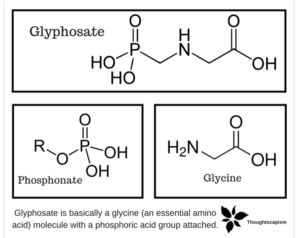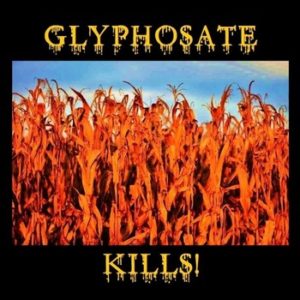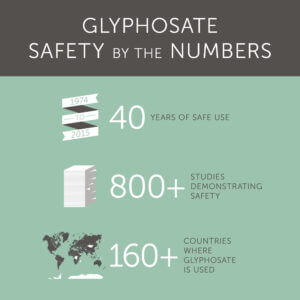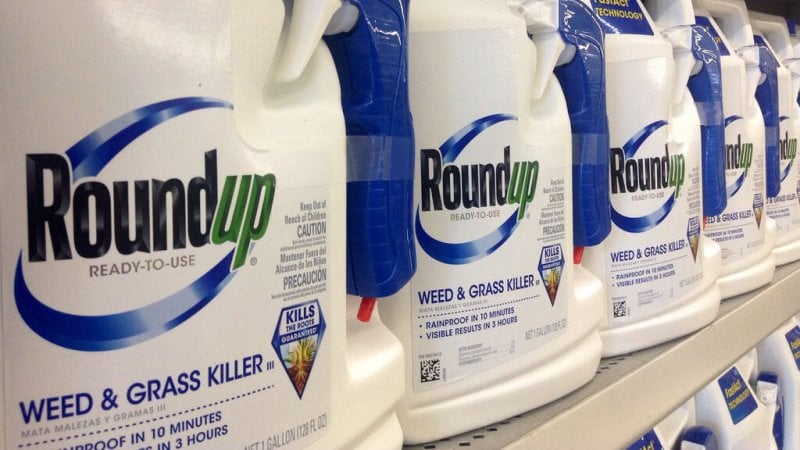The Genetic Literacy Project launches a multipart series examining the controversy over the herbicide glyphosate. Glyphosate is a garden herbicide introduced by Monsanto under the trade name Roundup in 1974 and off patent since 2000. It is often paired with herbicide tolerant genetically modified crops, including cotton, corn and soybeans. It allows farmers to spray a planted field, generally before the crops have sprouted, killing weeds but not the crops that will grow there.
GMO critics claim glyphosate is linked to autism, cancer, gluten allergies, ‘leaky gut’ syndrome and other disorders using correlation graphs or studies produced by well-known advocacy scientists. Concerns about glyphosate’s possible health impacts increased in 2015 after the International Agency for Research on Cancer, a research arm of the World Health Organization, classified glyphosate as “probably carcinogenic,” using what is called a hazard evaluation. The IARC classification was widely circulated by anti-chemical and ant-GMO advocacy groups, which argued for bans or tighter restrictions.
Glyphosate is derived from an amino acid, glycine. It acts by suppressing an essential biochemical  mechanism commonly found in plants, but not in animals. According to the Extension Toxicology Network, a joint pesticide information project by Cornell University, Michigan State University, Oregon State University and University of California-Davis, and funded by US Department of Agriculture, glyphosate is non-volatile, minimizing exposure through inhalation and undergoes little metabolism in the human body. If accidentally consumed, glyphosate is excreted mostly unchanged in feces and urine, so it doesn’t stay in the body and accumulate.
mechanism commonly found in plants, but not in animals. According to the Extension Toxicology Network, a joint pesticide information project by Cornell University, Michigan State University, Oregon State University and University of California-Davis, and funded by US Department of Agriculture, glyphosate is non-volatile, minimizing exposure through inhalation and undergoes little metabolism in the human body. If accidentally consumed, glyphosate is excreted mostly unchanged in feces and urine, so it doesn’t stay in the body and accumulate.
In our GMO FAQ section, the Genetic Literacy Project addresses the controversy: Is glyphosate (Roundup) dangerous? In this extended series, Finnish cell biologist Iida Ruishalme takes an in-depth dive into every aspect of the controversy. This series originally appeared in 17 parts on Dr. Ruishalme’s blog, Thoughtscapism. With the permission of the author, the GLP has combined some sections and condensed it and added some background to make it easier to access for our readers.
**********
Many worry about pesticides for health or environmental reasons, and the most common target of general concern is undoubtedly glyphosate, the active ingredient in the famous weedkiller RoundUp. I find that the best thing to do when something worries me, is to find out more about it. I’ve delved into the details behind the most common concerns I’ve encountered.
How toxic is glyphosate exactly? To examine toxicity, one must look at a chemical’s LD50 value–a standard measure of acute toxicity for chemicals, expressed in the amount of chemical (milligrams) per body weight (kg) that it took to kill fifty percent of a population of test animals. Caffeine is over ten times more toxic than glyphosate. With LD50 of 192 mg/kg, it would take 12,192 mg of caffeine to kill an average 140 lb human being. A typical 8 oz cup of coffee only contains 95 mg of caffeine, much lower than the dose required for acute toxicity. The same reasoning applies to glyphosate. Using similar calculations, it would take 12.5 oz of glyphosate to kill an average 140 lb human being. That means drinking three gallons of Roundup Original. Using scientific measures, glyphosate is less toxic than baking soda and salt.
But what about long-term exposure to glyphosate? Given its widespread use, there is a good chance that we are eating residues in our food. The US Environmental Protection Agency considered this in setting maximum safe levels of residues, called tolerances. EPA conducted a dietary risk assessment for glyphosate based on a worst-case risk scenario, that is, assuming that 100 percent of all possible acreage were treated, and that tolerance-level residues remained in/on all treated commodities. The agency concluded that there is no evidence of chronic dietary risk posed by glyphosate food use. A multi-university research project funded by the US Department of Agriculture concluded that glyphosate, if accidentally consumed, barely metabolizes, does not accumulate and is excreted mostly unchanged in feces and urine.
In 2014, the independent German Federal Institute for Risk Assessment (BfR)–which does risk assessments for the European Commission–concluded a review of hundreds of studies on glyphosate in a formal risk assessment, concluding:
[T]he available data do not show carcinogenic or mutagenic properties of glyphosate nor that glyphosate is toxic to fertility, reproduction or embryonal/fetal development in laboratory animals.
 But concerns over the herbicide flared in 2015 with the release of an evaluation by a World Health Organization research sub-group, the International Agency for Research on Cancer in 2015. Anti-GMO groups, which view glyphosate as a proxy for attacking crop biotechnology, had a field day. But the designation raised questions. IARC did no original research. It did not review the hundreds of studies as did the EPA, USDA and BfR in making their conclusions; it considered a few dozen, eliminating all studies with financial links to industry or in which a researcher had professional associations with industry, as well as hundreds of independent studies. The panel concluded glyphosate was “probably carcinogenic” to agricultural workers, writing:
But concerns over the herbicide flared in 2015 with the release of an evaluation by a World Health Organization research sub-group, the International Agency for Research on Cancer in 2015. Anti-GMO groups, which view glyphosate as a proxy for attacking crop biotechnology, had a field day. But the designation raised questions. IARC did no original research. It did not review the hundreds of studies as did the EPA, USDA and BfR in making their conclusions; it considered a few dozen, eliminating all studies with financial links to industry or in which a researcher had professional associations with industry, as well as hundreds of independent studies. The panel concluded glyphosate was “probably carcinogenic” to agricultural workers, writing:
Limited evidence of carcinogenicity in humans for non-Hodgkin lymphoma. The evidence in humans is from studies of exposures, mostly agricultural, in the USA, Canada, and Sweden published since 2001. In addition, there is convincing evidence that glyphosate also can cause cancer in laboratory animals.
The claim of carcinogenicity, as limited and muddled as it was, generated global headlines, with Nature notably noting, “Widely used herbicide linked to cancer.”
Why did such a discrepancy between the IARC hazard findings on glyphosate and risk assessments of the regulatory and mainstream science communities become international headlines in 2015?
How does IARC evaluate chemical toxicity?
IARC uniquely evaluates the health risks posed by different products or occupations. For example, it puts processed meat, excessive sunlight, and working as a hairdresser in the same hazard category–class 2A, “probably carcinogenic”–as plutonium and tobacco. It considers grapefruit juice and working the night shift to be as hazardous as glyphosate. Even more dangerous, in the organization’s opinion, are processed meat, sunlight, oral contraceptives, Chinese-style salted fish and alcohol–on the level of exposure to plutonium.
What confuses many people–the public and even some regulators–is that IARC does not actually look at how risky something may be–how long would a person have to be exposed to the sun or how much processed-meat a person would have to eat to lead to serious health problems. After all, almost anything can pose dangers if a person is exposed to it long enough–even water.
Said another way, Risk=Hazard x Exposure. IARC never actually examines what exposure levels are safe and what are not; it only looks at theoretical dangers, not actual ones. The scale IARC uses includes the following groups:
- 1) definitely carcinogenic
- 2a) and 2b), probably and possibly carcinogenic
- 3) not classifiable, and
- 4) probably not carcinogenic.
Bloomberg has a very user-friendly interactive graphic in its article, raising questions about IARC’s classification of red meat as a carcinogen probable carcinogen and processed meat as a definite carcinogen. The article provides an overview of a multitude of substances (and other exposures, such as in occupations) classified within the IARC system.
Bloomberg writes:
It’s important to note that the agents at the top aren’t necessarily the most dangerous. They’re the ones with the clearest evidence of hazard. WHO seeks to identify carcinogens “even when risks are very low at the current exposure levels, because new uses or unforeseen exposures could engender risks that are significantly higher,” the agency says. In other words, even though WHO has determined that red meat is a carcinogen, the report doesn’t quantify how much meat it would take to cross into the danger zone. here.
So far out of almost one thousand substances evaluated, IARC has designated only one as ‘probably not’ a carcinogen. Of course, most of the substances studied are chosen because it is suspected that they could pose health hazards. IARC does provide potentially useful information to help frame further research, just not the kind of information that a typical consumer might find helpful–and the results can be easily twisted into scare headlines or Internet memes.
IARC provides no insight about which kind of exposure would be significant for our day-to-day lives. It is not a valuable consumer information service. After the explosion of media attention after IARC classified meat as dangerous, science writer Ed Yong, writing for the Atlantic, called the sub-agency’s work confusogenic to humans.”
To steer ourselves away from the confusion, let’s remember that exposure and dosage remain the crucial questions when it comes to making good health choices.
There are several scientific review papers (collected here on this excellent resource wiki of the Food and Farm Discussion Lab) that have looked at real world data of glyphosate exposures and their connection to health effects. Four of these review articles look specifically at cancer and genotoxicity, and they all conclude that there is no connection between glyphosate and cancer incidence.
So how did IARC come to classify glyphosate as a probable carcinogen? To make things less confusogenic, University of Wyoming weed ecology professor Andrew Kniss constructed a graphic of what each of the major studies on glyphosate has found related to its potential for causing cancer.

The chart is an oversimplification, as Kniss has noted, but it illustrates that more than 20 studies have shown that glyphosate exposure can actually reduce the cancer risk in some instances–which underscores why scientists look at “weight of evidence” to make carcinogenic calculations rather than depending on a small sample of studies, as IARC did. Regulatory scientists, reviewing this contradictory evidence, have concluded that glyphosate has no predictive impact as to whether human exposure at normal levels would result in cancer.
If you are interested in the one spike–of Non-Hodgkins Lymphoma, it’s important to note that those were case-control studies in which the number of workers handling glyphosate (no study reviewed micro-trace amounts of glyphosate encountered in food) actually exposed to glyphosate was very small–tens, not hundreds of people–which is the standard for top-level studies, as Andrew Kniss noted.
Another graphic, this one in Vox–This is why you shouldn’t believe that exciting new medical study–illustrates why the IARC designation can be so misleading. Studies have indicated that almost everything we consume, from wine to butter to tomatoes–can be a deadly toxin, depending on how much one consumes.

From This is why you shouldn’t believe that exciting new medical study, based on Schoenfeld and Ioannidis paper in American Journal of Clinical Nutrition.
One way to sum this up: cancer – it’s not that simple. Evidence that seems to support or reject a hypothesis may be wrought with complexities that eludes simple interpretation. It is no wonder that it’s difficult for lay people to try to put all the data from scientific studies into proper context and perspective. Amanda Zaluckyj, a farmer who authors the blog The Farmer’s Daughter USA, brings some perspective to the controversy by reviewing the variety of things IARC classifies as 2A, probably carcinogenic. They include very hot beverages, wood dust and shift work for instance, “hazards” all of us can intuitively assess (it’s better not to eat all too much meat, or breath in wood dust, or exhaust and stress yourself with shift work):
The following things have also been included in the 2A classification: manufacturing glass, burning wood, emissions from high temperature frying, and work exposure as a hairdresser. But what’s even more revealing are the things that have been classified in Group 1, things that [definitely] cause cancer: drinking alcohol, formaldehyde, radon, solar radiation, wood dust, and estrogen. So these are things that will cause cancer, while glyphosate (according to IARC) might cause cancer.
So, if glyphosate could cause cancer, does it? According to several reliable sources, no.
 An actual risk assessment on glyphosate by the WHO and the United Nations Food and Agricultural Organisation (FAO) finds no reason to think glyphosate in the amounts found in our food or through normal occupational exposure would be carcinogenic to humans.
An actual risk assessment on glyphosate by the WHO and the United Nations Food and Agricultural Organisation (FAO) finds no reason to think glyphosate in the amounts found in our food or through normal occupational exposure would be carcinogenic to humans.
No major international regulatory advisory agency had previously concluded glyphosate posed health risks. The European Food Safety Authority (EFSA, report here), as well as the German Federal Institute for Risk Assessment (BfR statement here, and their evaluation in English here), have also reached the same conclusion. A joint panel from the World Health Organization and the Food and Agriculture Organization of the United Nations reviewed the IARC findings after they were released and issued its report on glyphosate, in May 2016, concluding glyphosate poses no cancer risks as encountered in food and does not impact our genes. The toxicity was so low, the joint committee wrote, it was not necessary to establish an ARfD–an acute toxicity reference dose often used to regulate risk. It’s also reviewed its impact on workers, noting that the only “high quality” study found no evidence of a cancer link.
In September 2016, the US Environmental Protection Agency issued what is considered one of the most comprehensive reviews of the pertinent studies on glyphosate ever undertaken, authored by 13 prominent independent scientists, concluding:
…there is not strong support for the “suggestive evidence of carcinogenic potential” cancer classification descriptor based on the weight-of-evidence, which includes the fact that even small, non-statistically significant changes observed in animal carcinogenicity and epidemiological studies were contradicted by studies of equal or higher quality. The strongest support is for “not likely to be carcinogenic to humans” at the doses relevant to human health risk assessment for glyphosate.
Steve Palkin, a Canadian journalist and host of The Agenda, has put together an informative 15-minute video featuring the views of two scientists. They discuss the difference between a ‘hazard’ and a ‘health risk’ by likening the risk of glyphosate to a person visiting a zoo. Is the bear in the zoo a risk to your life? In the right (well, wrong) context, yes. But should you be afraid to visit the zoo because of this remote hazard? No.
Iida Ruishalme, Finnish by birth and now a Swedish resident, is a cell biologist and science communicator, and author of the Thoughtscapism blog, which is where this piece originally appeared–here. She is also a fiction writer and a contributor to Genetic Literacy Project, Skepti-Forum, and Biofortified, as well as to the cultural journal The Woolf. Twitter: @Thoughtscapism































